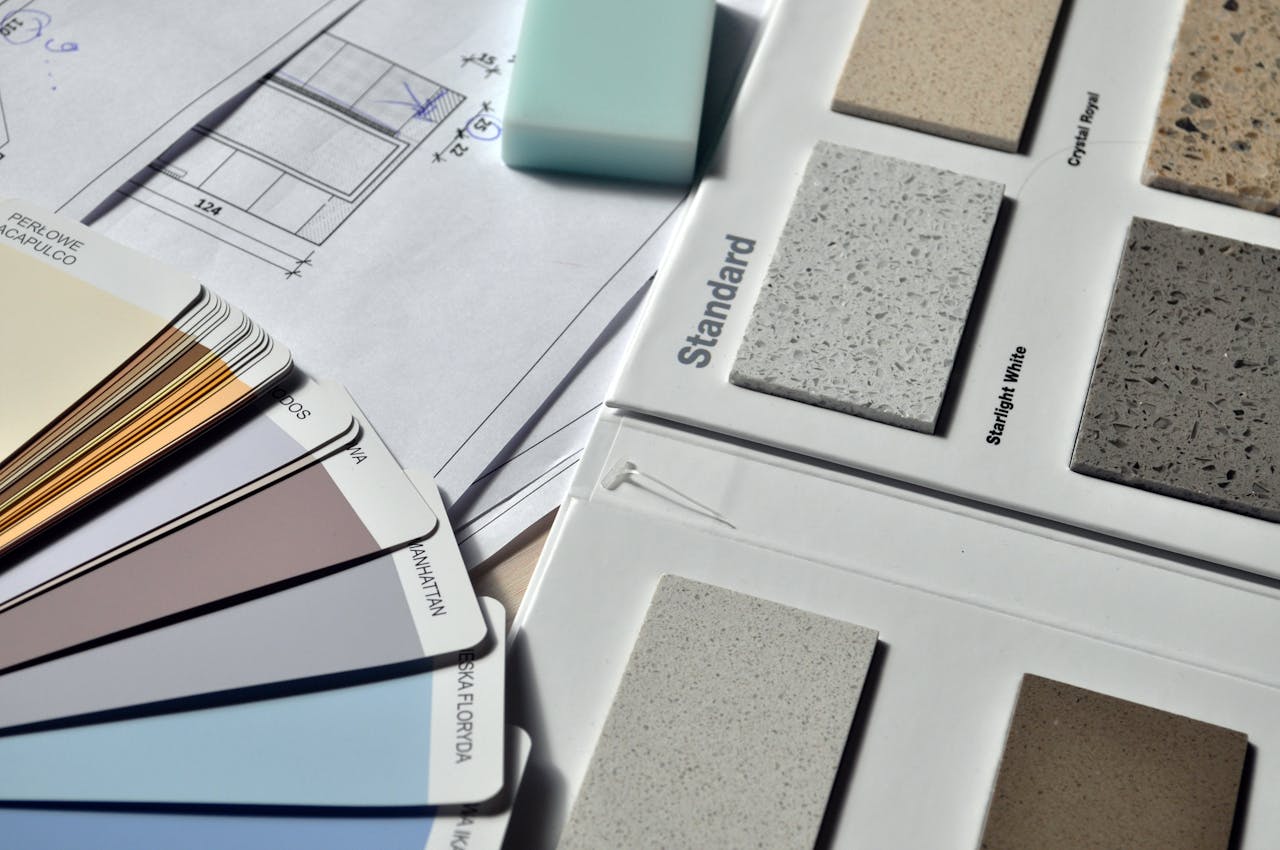Choosing The Best Luxury Vinyl Tile For Bathrooms

Are you contemplating a bathroom makeover but overwhelmed by flooring choices? It’s easy to do. However, the appeal of luxury vinyl tile (LVT) flooring is unmistakable, with its rising popularity showcasing a wealth of options for homeowners. Particularly in bathroom renovations, likely due to its water resistance and wood-like appearance, the value add is significant and offers a promising return on investment. Unlike its predecessors, modern vinyl flooring is a resilient, synthetic marvel that gracefully occupies spaces once reserved for traditional ceramics, porcelain tiles, or hardwoods, bringing versatility and style to the modern bathroom.
The desire for luxury vinyl tile (LVT) in home flooring has witnessed a remarkable surge, particularly within the confines of the bathroom. Understanding the duration of a bathroom renovation can help you plan your renovation effectively. This trend is not merely a fleeting one; it reflects a deeper recognition of how minor cosmetic updates, especially in flooring, can substantially enhance a home's value. Homeowners are increasingly turning to LVT for its unique blend of aesthetic appeal and practical functionality, transforming ordinary spaces into elegant ones.
Understanding Luxury Vinyl Tile (LVT)
Luxury vinyl tile stands out for its exceptional characteristics, especially suited to bustling households adorned with the lively chaos of children and pets. Unlike its traditional counterpart, LVT boasts a remarkable thickness and durability, paralleled with an uncanny realism in design that mimics more opulent materials like stone or hardwood. Its waterproof nature makes it an unrivaled choice for bathroom settings, providing homeowners with both style and peace of mind. Furthermore, LVT offers a tactile experience that bridges the gap between its illustrious appearance and the functional demands of daily life, setting it apart from conventional stone or ceramic tiles.
The Composition of Vinyl Flooring
At its core, vinyl flooring is primarily composed of PVC (polyvinyl chloride), lending it durability and flexibility. Traditional forms, such as sheet vinyl or vinyl tiles, feature a composite structure where a PVC layer is bonded to a fibrous core. The quality of vinyl flooring is largely dependent on the thickness of the material, the toughness of the wear layer, and the type of backing used, all contributing to its longevity and resilience.
The 3 Types of Vinyl Flooring
Vinyl Composite Tile (VCT)
This economical option is great for DIY enthusiasts, made from a mix of limestone, filler materials, thermoplastic binders, and color pigments. While VCT requires surface polishing for protection, it is somewhat vulnerable to water penetration due to its seams.
Pros and cons
- Economical and suitable for DIY installation.
- Made from limestone, filler materials, thermoplastic binders, and color pigments.
- Requires surface polishing for protection.
- Vulnerable to water penetration due to seams.
▪ Costs range: VCT itself typically costs between ~$0.50 to $2.50 per square foot
Sheet Vinyl
For areas where waterproofing is paramount, sheet vinyl excels. Its continuous sheets minimize seams, offering enhanced water resistance. The design is achieved through a digital graphics "film" layer of PVC.
Pros and cons
- Ideal for spaces requiring full waterproofing.
- Continuous sheets offer more water resistance due to fewer seams.
- Made with a digital graphics "film" layer of PVC for design.
▪ Costs range: The average cost range for sheet vinyl flooring typically falls between ~$0.50 and $2.00 per square foot for the material alone. This price can vary based on the quality, design, thickness, and brand of the sheet vinyl. High-end luxury sheet vinyl with more elaborate designs and enhanced durability features can cost more, sometimes up to $5.00 per square foot or higher.
Luxury Vinyl Flooring (LVF)
For those seeking a high-end look with the practicality of waterproofing, LVF, including LVT and luxury vinyl planks (LVP), is ideal. Comprising a limestone-based mineral blend mixed with PVC composites, LVF can convincingly mimic wood, stone, ceramics, or even metal.
Pros and cons
- Suitable for a high-end look in waterproof spaces.
- Known as luxury vinyl tile (LVT) or luxury vinyl planks (LVP).
- Made of limestone-based mineral material mixed with PVC composites.
- Can mimic wood, stone, ceramics, or metal.
▪ Costs range: The average cost range for Luxury Vinyl Flooring (LVF), which includes both Luxury Vinyl Tile (LVT) and Luxury Vinyl Planks (LVP), typically falls between ~$2.00 and $7.00 per square foot for the material alone.
The Top Benefits of Vinyl Flooring
The durability of LVT makes it perfect for homes bustling with kids, pets, or high foot traffic. Its 100% waterproof styles, ease of cleaning, comfort underfoot, slip resistance, simple installation, affordability, and wide range of design options make it a versatile choice for any space.
Additional benefits include:
- Design Realism: It offers designs that closely mimic more expensive materials like stone or hardwood, providing an uncanny realism in appearance.
- Waterproof Nature: LVT's waterproof properties make it an ideal choice for wet environments such as bathrooms, offering both style and functionality.
- Ease of Maintenance: It is relatively low-maintenance, requiring regular sweeping and occasional mopping with a mild cleaner to keep it looking pristine.
- Ease of Installation: Known for its ease of installation, LVT can be a suitable DIY project, allowing for quick and easy room transformations.
- Comfort and Quiet: The multi-layer construction of LVT provides a comfortable and quiet walking surface, which is softer underfoot compared to traditional stone or ceramic tiles.
- Cost-Effectiveness: LVT offers a cost-effective alternative to achieve the look of natural materials without the high price tag, providing good value for money.
- Versatility: With a wide range of styles and finishes, LVT is suitable for almost any room in your home, enhancing its versatility and appeal.
- Resilience to Damage: Its flexibility and resilience mean it's less likely to crack or chip, making LVT a forgiving option in case of accidents.
- Tactile Experience: LVT bridges the gap between aesthetic appeal and practical functionality, offering a tactile experience that enhances the overall feel of the space.
The Biggest Drawbacks of Vinyl Flooring
Despite its many advantages, vinyl flooring can be challenging to repair if damaged. Additionally, installing LVT in bathrooms requires different considerations compared to other rooms, due to the unique moisture and humidity levels.
Other considerations include:
- Tactile Experience: While LVT can visually mimic natural materials, it may lack the same tactile feel, which could be important for some homeowners. Visiting showrooms to experience LVT firsthand is recommended.
- Environmental Considerations: In very damp environments, careful selection of LVT is advised to ensure it performs well over time without damage.
- Material Perception: Some individuals may perceive LVT as less luxurious compared to traditional materials like hardwood or natural stone, which could influence their choice.
Vinyl Flooring in Specific Areas of the Home
LVT is versatile enough for installation in various home areas, from gathering spaces and utility areas to kitchens and bathrooms. For bathroom projects, knowing the bathroom renovation timeline can be particularly beneficial. However, it is generally not recommended for use on stairs due to safety and wear considerations.
Vinyl as an Alternative to Other Materials
LVT stands out as a superior alternative to hardwood in moisture-prone areas, offering a similar aesthetic without the susceptibility to water damage. Compared to ceramic, LVT provides additional warmth, softness underfoot, and more realistic design options, making it a preferred choice for many homeowners.
The preference for grout-less flooring solutions is on the rise, driven by their sleek aesthetics and low-maintenance appeal. While options like sheet vinyl, hardwood, and laminate present themselves as contenders, LVT holds its ground, especially when juxtaposed with ceramic tiles. The comparison extends beyond mere aesthetics to encompass aspects such as cost-efficiency, resale value, and a diverse array of shapes and sizes. LVT not only rivals the durability and ease of maintenance offered by ceramic tiles but also introduces a level of design versatility and installation ease that is hard to match, making it a compelling alternative to traditional hardwood and ceramic flooring.
The Key Differences Between Luxury Vinyl Tile (LVT) and Other Popular Flooring Options

Vinyl Flooring Styles and Collections
The versatility of LVT designs is vast, with collections offering realistic imitations of various wood species, textures, stone styles, and more. This diversity allows homeowners to tailor their flooring to match any interior design theme.
Installation and Care
LVT is celebrated for its DIY-friendly installation methods, including repositionable self-adhesive, floating floor, and glue-down options. Proper installation ensures waterproofing in bathrooms, protecting against steam and water spills. LVF's durability makes it suitable for high-traffic areas, with its cost-effectiveness and straightforward installation adding to its appeal. Maintenance of luxury vinyl planks is also easy, requiring minimal effort to keep the flooring looking its best.
Conclusion
In the search for the ideal bathroom flooring, luxury vinyl tile stands out as a robust, stylish, and practical option. Its versatility, ease of care, and wide range of designs make it a compelling choice for homeowners looking to combine aesthetics with functionality.
From personal renovation experiences to industry trends, it’s clear that LVT’s impact extends beyond just visual upgrades. Its installation can genuinely transform a home’s comfort and value. Whether you're looking to enhance a single bathroom or revamp multiple spaces, the right LVT choice can offer elegance and resilience in equal measure.
For those interested in exploring luxury vinyl tile further, numerous resources are available, including manufacturer guides, installation tutorials, and design inspiration galleries, providing everything needed to embark on a successful bathroom renovation with LVT.
You can also reach out to a Revive Property Advisor who works closely with our Interior Design team to assist you with your next renovation project.
A student at Academy of Art University with hands-on design experience from Hibner Design Group. Skilled in CAD and project management, Sydney seamlessly blends academic insights with practical design know-how.
Recent articles
Unlocking equity is hard,
we've got your back.
See what's possible, it's your real estate.
Discuss homeThe future
starts at home.
While there is an abundance of evidence that supports that renovated turnkey homes sell faster and for more, Revive, nor the Contractor, can guarantee a specific as-is or after renovation value or the exact time that it would take to get a renovated home sold. Further, Revive cannot provide a guarantee that the real estate market will not experience fluctuations or a decrease during the renovation or sales period.








